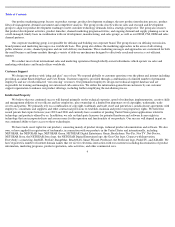Netgear 2009 Annual Report Download - page 21
Download and view the complete annual report
Please find page 21 of the 2009 Netgear annual report below. You can navigate through the pages in the report by either clicking on the pages listed below, or by using the keyword search tool below to find specific information within the annual report.
Table of Contents
Traditional retailers have limited shelf space and promotional budgets, and competition is intense for these resources. If the networking
sector does not experience sufficient growth, retailers may choose to allocate more shelf space to other consumer product sectors. A competitor
with more extensive product lines and stronger brand identity, such as Cisco Systems, may have greater bargaining power with these retailers.
Any reduction in available shelf space or increased competition for such shelf space would require us to increase our marketing expenditures
simply to maintain current levels of retail shelf space, which would harm our operating margin. The recent trend in the consolidation of online
retailers and DMR channels has resulted in intensified competition for preferred product placement, such as product placement on an online
retailer’s internet home page. Expanding our presence in the VAR channel may be difficult and expensive. We compete with established
companies that have longer operating histories and longstanding relationships with VARs that we would find highly desirable as sales channel
partners. We also sell products to broadband service providers. Competition for selling to broadband service providers is intense. Penetrating
service provider accounts typically involves a long sales cycle and the challenge of displacing incumbent suppliers with established relationships
and field-deployed products. If we were unable to maintain and expand our sales channels, our growth would be limited and our business would
be harmed.
We must also continuously monitor and evaluate emerging sales channels. If we fail to establish a presence in an important developing
sales channel, our business could be harmed.
We depend on a limited number of third party manufacturers for substantially all of our manufacturing needs. If these third party
manufacturers experience any delay, disruption or quality control problems in their operations, we could lose market share and our
brand may suffer.
All of our products are manufactured, assembled, tested and generally packaged by a limited number of original design manufacturers
(“ODMs”), contract manufacturers (“CMs”) and original equipment manufacturers (“OEMs”). We rely on our manufacturers to procure
components and, in some cases, subcontract engineering work. Some of our products are manufactured by a single manufacturer. We do not
have any long-term contracts with any of our third party manufacturers. Some of these third party manufacturers produce products for our
competitors. Due to weak economic conditions, the viability of some of these third party manufacturers may be at risk. The loss of the services
of any of our primary third party manufacturers could cause a significant disruption in operations and delays in product shipments. Qualifying a
new manufacturer and commencing volume production is expensive and time consuming.
Our reliance on third party manufacturers also exposes us to the following risks over which we have limited control:
All of our products must satisfy safety and regulatory standards and some of our products must also receive government certifications. Our
ODMs, CMs and OEMs are primarily responsible for obtaining most regulatory approvals for our products. If our ODMs, CMs and OEMs fail to
obtain timely domestic or foreign regulatory approvals or certificates, we would be unable to sell our products and our sales and profitability
could be reduced, our relationships with our sales channel could be harmed, and our reputation and brand would suffer.
Specifically, substantially all of our manufacturing occurs in mainland China and any disruptions from natural disasters, health epidemics
and political, social and economic instability would affect the ability of our ODMs to manufacture our products. If our manufacturers or
warehousing facilities are disrupted or destroyed, we would have no other readily available alternatives for manufacturing our products and our
business would be
19
•
unexpected increases in manufacturing and repair costs;
•
inability to control the quality of finished products;
•
inability to control delivery schedules; and
•
potential lack of adequate capacity to manufacture all or a part of the products we require.
























